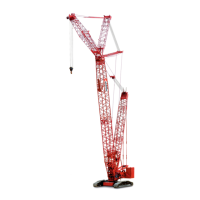National Crane PUBLISHED 04-26-2019 CONTROL # 113-09 3-13
600E2 OPERATOR MANUAL OPERATING CONTROLS AND PROCEDURES
the socket. The dead-end treatment is used to restrain
the wedge from becoming dislodged from the socket
should the rope suddenly become unloaded due to the
overhaul ball or hook block striking the ground, etc.
Sketches A through F (Figure 3-8) illustrate various ANSI
approved methods for treating the dead-ends of wire ropes
which exit a wedge socket assembly. While use of the loop-
back method is acceptable, care must be exercised to avoid
the loop becoming entangled with tree branches and other
components during crane transport and with the anti-two
block system and other components during use of the crane.
Of the methods shown below, National Crane prefers that
method A or F be used, i.e., clipping a short piece of wire
rope to the dead-end or using a commercially available
specialty clip or wedge. Typically, it is recommended that the
tail length of the dead-end should be a minimum of 6 rope
diameters but not less that 6 in (15.2 cm) for standard 6 to 8
strand ropes and 20 rope diameters but not less than 6 in
(15.2 cm) for rotation resistant wire ropes.
When using method A, place a wire rope clip around the
dead end by clamping a short extra piece of rope to the rope
dead end. DO NOT CLAMP THE LIVE END. The U-bolt
should bear against the dead end. The saddle of the clip
should bear against the short extra piece. Torque the U-bolts
according to the table titled Wire Rope Clip Torque Values
(Table 3-1).
Other sources for information with which crane users should
be familiar and follow is provided by the American Society of
Mechanical Engineers, American National Standard, ASME
B30.5, latest revised. ASME (formerly ANSI) B30.5 applies
to cableways, cranes, derricks, hoists, hooks, jacks, and
slings. It states, in section 5-1.7.3, “(c) Swagged,
compressed, or wedge socket fittings shall be applied as
recommended by the rope, crane or fitting manufacture.”
Wire ropes are addressed in ASME B30.5, section 5-1.7.2,
ROPES, it states, in pertinent part, “(a) The ropes shall be of
a construction recommended by the rope or crane
manufacturer, or person qualified for that service.” Additional
information is published by the Wire Rope Technical Board in
the Wire Rope Users Manual, latest revised edition.
Table 3-1
Wire Rope Clip Torque Values
Clip Sizes Torque
Inches mm lb-ft Nm
1/8 3.18 4.5 6
3/16 4.76 7.5 10
1/4 6.35 15 20
5/16 7.94 30 40
3/8 13.28 45 60
7/16 11.11 65 90
1/2 12.70 65 90
9/16 14.29 95 130
5/8 15.88 95 130
3/4 19.05 130 175
7/8 22.23 225 300
1 25.40 225 300
1-1/8 28.58 225 300
1-1/4 31.75 360 490
1-3/8 38.68 360 490
1-1/2 38.10 360 490
FIGURE 3-8
Wedge Socket
Specialty Clip
Specialty Wedge
Fo
r
Reference
Only

